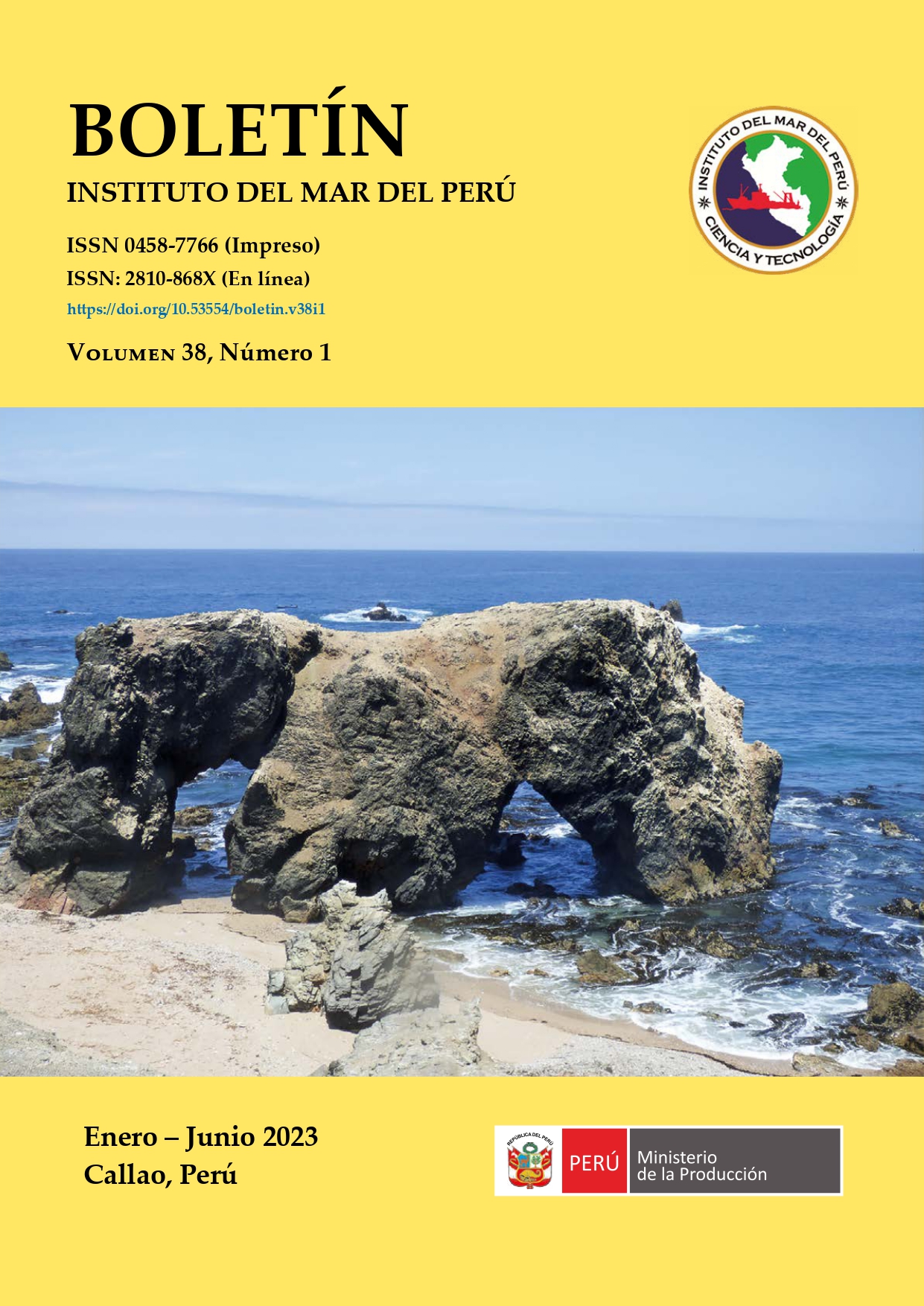Oceanographic and chemical conditions in the water column overlying to the Nazca Ridge
DOI:
https://doi.org/10.53554/boletin.v38i1.380Keywords:
Nazca Ridge, Perú, Nutrients, Water masses, Oceanographic variablesAbstract
The Nazca Ridge is a deep-sea ecosystem spanning 1,000 km in length and 300 km in width as well as forming part of National Reserve of the same name. This area, located off the coast of the Ica Region (Peru), is renowned for its remarkable biodiversity. To enhance our understanding of the biological and oceanographic characteristics, a comprehensive study was conducted during the summer of 2020 in collaboration with the Peruvian Directorate of Hydrography and Navigation (DHN) and the crew of BAP Carrasco. We aimed to characterize the oceanographic, chemical, and geological conditions in the region. The investigation focused on analyzing nutrient levels, dissolved oxygen, productivity, and their correlation with water masses and oceanographic variables. A total of nine hydrographic stations were established along the Nazca Ridge, reaching depths of up to 2,800 m. The study revealed the influence of various water masses on the system, including Subtropical Surface Waters (SSW), Equatorial Subsurface Waters (ESSW), Antarctic Intermediate Waters (AAIW), and Pacific Deep Waters (PDW). Each water mass exhibited distinct temperature and salinity characteristics consistent with previous research. Notably, SSW displayed high dissolved oxygen levels, low nutrient concentrations, and elevated productivity. Dissolved oxygen was found to be highest within the uppermost 30 m, with the base of the oxycline occurring around 30 m. Between 50 m and 750 m, the oxygen minimum zone (OMZ) (<0.5 mL/L) corresponded to the distribution of ESSW, while concentrations increased below 1,500 m, nearing 2 mL/L in association with deep waters. Nutrient concentrations, including phosphates, silicates, and nitrates, were relatively low in surface waters due to phytoplankton consumption. However, concentrations increased with depth, particularly in relation to AAIW and PDW.
Downloads
Alternative Metrics
Metrics
References
Ancapichún, S. & Garcés-Vargas, J. (2015). Variability of the Southeast Pacific Subtropical Anticyclone and its impact on sea surface temperature off northcentral Chile. Ciencias Marinas, 41(1), 1-20. https://doi.org/10.7773/cm.v41i1.2338
Flores, R., Espino, M., Luque, G. & Quispe, J. (2013). Patrones de Variabilidad Ambiental en el Mar Peruano. Rev. peru. biol. Número especial, 20(1), 21-28. https://doi.org/10.15381/rpb.v20i1.2630
Gálvez-Larach, M. (2009). Montes submarinos de Nazca y Salas y Gómez: una revisión para el manejo y conservación. Lat. Am. J. Aquat. Res., 37(3), 479-500. https://doi.org/10.3856/vol37-issue3-fulltext-16
Graco, M., Ledesma, J., Flores, G. & Girón, M. (2007). Nutrientes, oxígeno y procesos biogeoquímicos en el sistema de surgencias de la corriente de Humboldt frente a Perú. Rev. peru. biol., 14(1), 117- 128. https://doi.org/10.15381/rpb.v141.2165
Grados, C., Chaigneau, A., Echevin, V. & Dominguez, N. (2018). Upper Ocean Hydrology of the Northern Humboldt Current System at seasonal, interannual and interdecadal scales. Progress in Oceanography, 165, 123-144. https://doi.org/10.1016/j.pocean.2018.05.005
Hagen, R. & Moberly, R. (1994). Tectonic Effects of a Subducting Aseismic Ridge: The Subduction of the Nazca Ridge at the Peru Trench. Mar. Geophys. Res., 16, 145–161. https://doi.org/10.1007/BF01224757
Hamersley, M. R., Lavik, G., Woebken, D., Rattray, J., Lam, P., Hopmans, E. C., Sinninghe Damste, J. S., Krüger, S., Graco, M., Gutiérrez, D. & Kuypers, M. M. M. (2007). Anaerobic ammonium oxidation in the Peruvian oxygen minimum zone. Limnol. Oceanogr., 52(3), 923-933. https://doi.org/10.4319/lo.2007.52.3.0923
Ledesma, J., Tam, J., Graco, M., León, V., Flores, G. & Morón, O. (2011). Caracterización de la Zona de Mínimo de Oxígeno (ZMO) frente a la costa peruana entre 3°N y 14°S, 1999 – 2009. Bol Inst Mar Perú, 26(1-2), 49–57.
https://biblioimarpe.imarpe.gob.pe/handle/20.500.12958/2160
Mix, A.C., Tiedemann, R. & Blum, P. (2003). Leg 202 Shipboard Scientific Party. Proceedings of the Ocean Drilling Program (OPD) Initial Reports, College Station, 202, 1-145. https://doi.org/10.2973/odp.proc.ir.202.101.2003
Schneider, W., Fuenzalida, R., Rodríguez-Rubio, E., Garcés-Vargas, J. & Bravo, L. (2003). Characteristics and formation of eastern South Pacific Intermediate Water. Geophys. Res. Lett., 30(11), 1581. https://doi.org/10.1029/2003GL017086
SERNANP. (2021). Expediente técnico: Reserva Nacional Dorsal de Nazca (RNDN00462021), pp. 109. https://www.gob.pe/institucion/sernanp/informespublicaciones/1952627-reserva-nacional-dorsal-deNazca
Silva, N., Rojas, N. & Fedele, A. (2009). Water masses in the Humboldt Current System: Properties, distribution, and the nitrate deficit as a chemical water mass tracer for Equatorial Subsurface Water off Chile. Deep Sea Research Part II: Tropical Studies in Oceanography, 56(16). 1004-1020. https://doi.org/10.1016/j.dsr1.2008.12.013
Strickland, J. & Parsons, T. (1972). A Practical Handbook of Sea Water Analysis. Bull Fish. Res. Bd. Canada, (167), 1-311. https://dx.doi.org/10.25607/OBP-1791
Tassara, A., Götze, H., Schmidt, S. & Hackney, R. (2006). Three-dimensional density model of the Nazca plate and the Andean continental margin. Journal of Geophysical Research, 111(B09404), 1-26. https://doi.org/10.1029/2005JB003976
Tsuchiya, M. & Talley, L. (1998). A Pacific hydrographic section at 881°W: water- property distribution. Journal of Geophysical Research, 13(C6), https://doi.org/10.1029/97JC03415
Woods, M. & Okal, E. (1994). The structure of the Nazca ridge and Sala y Gomez sea mount chain from the dispersion of Rayleigh waves. Geophys. J. Int., 117(1), 205-222. https:// doi.org/10.1111/j.1365-246X.1994.tb03313.x
Zuta, S. & Guillén, O. (1970). Oceanografía de las Aguas Costeras del Perú. Bol Inst Mar Perú, 2(5), 157-324. https://bibloimarpe.imarpe.gob.pe/handle/20.500.12958/949
Downloads
Published
How to Cite
Issue
Section
License
Copyright (c) 2023 Boletin Instituto del Mar del Perú

This work is licensed under a Creative Commons Attribution 4.0 International License.










